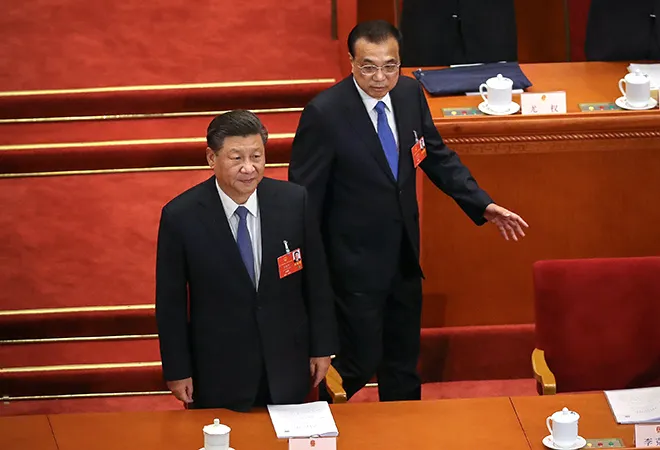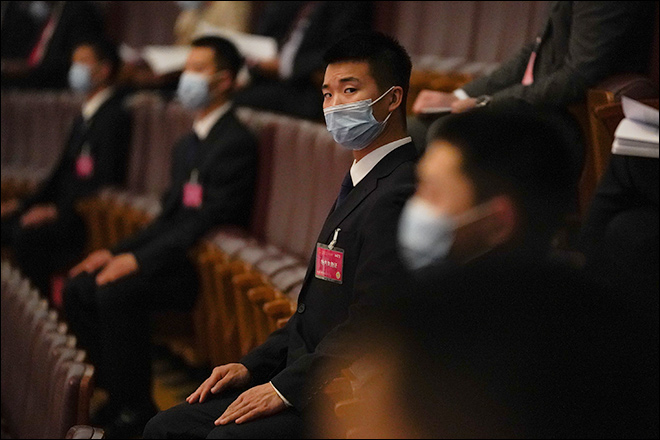-
CENTRES
Progammes & Centres
Location
The most obvious solution is to ramp up China’s welfare state to support the workers who will be left out in the process. The rationale for this is not only fairness or pure populism, but rather economic efficiency.

It is hard to think of a more important gathering than this year’s Two Sessions, in which Chinese political leaders guide all of us to the way ahead for the Chinese economy. After delaying this gathering due to the coronavirus pandemic and a hesitant approach towards stimulus because of the outbreak — the global attention on this meeting has been higher than ever.
Such expectations had been centred on two key issues: the leadership’s announcement (or lack thereof) of a GDP growth target for 2020. The growing consensus against such target has a strand of observers calling for a two-year target. This could be justified by the special circumstances related to COVID-19, coupled with the need to guide expectations beyond 2020. Guiding expectations seem particularly important, since 2020 marks the end of the current Five-Year Plan and the 10-year period in which China aimed to double its income. It is also the operational target against which President Xi Jinping’s Great Rejuvenation plan is to be measured. The end result has been no target, which should be understood to mean that gaining flexibility is more important that stability. Given the importance of stability in China’s economic management, opting for flexibility seems to point towards low expectations for economic activity this year and probably next year. The rather high unemployment target (6% which is the level last April) also hints at poor growth awaiting us.
The second key issue is the size of the stimulus which Premier Li Keqiang would have announced. It is by now clear that expectations were generally running low compared to actual announcements. On the monetary side, reference to lower interest rates and a higher inflation target point to a much laxer monetary policy ahead. On the fiscal side, a bigger stimulus can be expected from the announced quota increase for local government bonds from RMB 2.6 trillion last year to RMB 3.75 trillion. As if a nearly 40% increase in additional financing for local governments is not enough, an additional RMB 1 trillion in Special Treasury Bonds has been announced. It should be noted that the last time the Chinese government resorted to these types of off-balance-sheet bonds was in 2007. Finally, the magic of it all is that the target for the fiscal deficit remains low for the sharp increase in bond issuance, namely at 3.6% of GDP in 2020.
The combination of a large stimulus without a growth target points to the worrisome fact that China’s recovery is far from complete — two months after COVID-19 was brought under control. This is especially true for the demand side. External demand remains extremely weak as virtually the whole world has been hit by the pandemic. More worryingly, domestic demand also remains weak, as indicated by meagre retail sales and looming deflationary pleasures.
 “One should expect financial repression to remain even more pervasive — supported by capital controls — so as to cushion the negative impact of climbing public debt to counter the pandemic.” © Andrea Verdelli/Getty
“One should expect financial repression to remain even more pervasive — supported by capital controls — so as to cushion the negative impact of climbing public debt to counter the pandemic.” © Andrea Verdelli/GettyThe need for more stimulus is, thus, a no-brainer and Premier Li’s announcement should be welcome. The problem, though, is that there is no such thing as a free lunch. The mirror of additional stimulus is more leverage. The announced fiscal stimulus will raise public debt further, unless new fiscal revenue can be found. The latter looks very unlikely unless the leadership decides to divest assets. The pre-announced land reform should also help generate wealth for the rural population, but it is hard to see how this would reduce public debt. If anything, it may even raise it as there may be a transfer of wealth from local governments (with less land sale revenue) to the rural population. Absent a privatisation programme, all forces point towards higher public debt due to the stimulus announced in these Two Sessions. Our estimates of China’s consolidated fiscal deficit have hovered around 8% during the last few years, which implies that public debt had been climbing even before COVID-19. While most of the increase is associated with local government financing vehicles, it seems clear that China’s fiscal space is not as large as it used to be. If we also consider the fact that a significant part of China’s corporate debt is in the hands of state-owned companies (about 60% using the universe of listed companies), public debt on a consolidated basis would be higher than that of US or most European countries. The good news, though, is that China has enough domestic savings to hold this debt domestically. In other words, solutions can be found to reduce the size of the debt once the negative economic consequences of the pandemic are fully under control. In this regard, one should expect financial repression to remain even more pervasive — supported by capital controls — so as to cushion the negative impact of climbing public debt to counter the pandemic.
The final question, for which not much guidance has been offered from Premier Li, is how this money will be spent. It goes without saying that an effective stimulus should be oriented to productive activity, which might not be so obvious. This is a result of pervasive over-investment in many sectors, certainly infrastructure and real estate, among others. In other words, the limit to the stimulus announcement might not necessarily be debt dynamics, which we believe can be managed due to China’s excess and trapped savings, but rather the room to find profitable projects to invest in. Within this context, several actors are pushing to use this opportunity to further enhance China’s digital infrastructure. While this is clearly welcome, it is important to be aware that this strategy might not be able to create the necessary jobs needed to sustain employment and disposable income. This also means that the temptation for Chinese leaders to give up on such high hopes and use the stimulus for more labour-intensive and well-known sectors, such as infrastructure and real estate.
To embark on a more targeted and productive stimulus, other measures will be needed to keep labour accompanied and thereby their disposable income stable. The most obvious solution is to ramp up China’s welfare state to support the workers who will be left out in the process. The rationale for this is not only fairness or pure populism, but rather economic efficiency. A better allocation of resources can cushion China’s unavoidable structural deceleration. The productivity gains, however, need to be used to support household income through fiscal transfers so that China’s long-standing pursuit of a consumption-led growth model can be achieved. There is no better rejuvenation for a society than to be able to provide enough safety nets for the losers, while moving up the ladder through innovation. With such a policy mix, the pandemic might indeed pass in China’s history as the opportunity that the leadership grasped to modernise the economy.
All in all, having ditched the growth target is positive news for China but, it offers a worrisome hint at the state of the economy especially when considering the large monetary and fiscal stimulus. How this stimulus will be put to work will be essential for the world. If reoriented towards targeted and productive investment, growth may be resumed more easily, but perhaps not employment. For the latter, and to maintain the necessary income to consume, protecting households through the creation of a stronger welfare state seems warranted.
The views expressed above belong to the author(s). ORF research and analyses now available on Telegram! Click here to access our curated content — blogs, longforms and interviews.

Alicia Garca Herrero is a Senior Fellow at European think-tank BRUEGEL. She is also the Chief Economist for Asia Pacific at Natixis and non-resident Research ...
Read More +